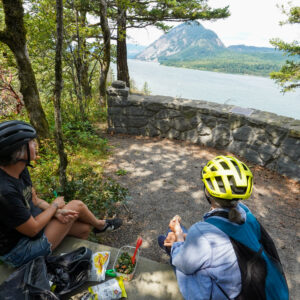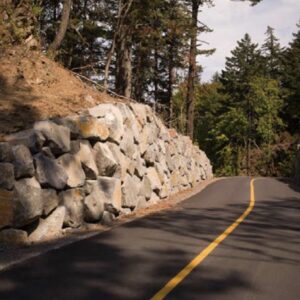
The Columbia River Crossing Project is rounding up bicycle and pedestrian advocates to sit on an advisory committee.
Here’s the email invite:
“You have been identified as a potential member of the Columbia River Crossing project’s Pedestrian and Bicycle Advisory Committee.
The committee will meet every four to six weeks over the next several months to review and provide input on pedestrian and bicycle issues and needs in the project study area.”
Their first meeting is planned for March 28th.
In the future, I hope bike and ped advocates have much louder and clearer voices at the inception of major transportation projects. This project for instance is about much larger and more important issues than simply getting a nice, wide bike path over the bridge.
In other CRC news, today is the first meeting of the Rex Burkholder-led subcommittee to find a sensible alternative to the $6B mega-highway bridge (more at the Portland Tribune).






Thanks for reading.
BikePortland has served this community with independent community journalism since 2005. We rely on subscriptions from readers like you to survive. Your financial support is vital in keeping this valuable resource alive and well.
Please subscribe today to strengthen and expand our work.
Wow! The cheek of that blows my mind! We’re gonna build Gargantua with 12 lanes for automobiles, but, oh, now that we’ve set on that, we want you to help us give it a “bikewash”. I don’t care how wide a bike lane they put on it, the bridge as proposed is going to seriously degrade the cycling environment in both Portland AND Clark County.
If Jonathan is going to be on the committee, then I’m confident he’ll make sure the committee represents the interests of ALL bicyclists and pedestrians (which is to say, everyone) who will be affected by the freeway expansion, not just people who want to walk or bike across the bridge.
The more I think about this bridge expansion the more irritated I get. I know this subject has been discussed before but I just want to add my 2¢ even if it’s already been added.
First, during most times of the day the bridge is uncongested and easy to cross. Even during rush hour it’s not bad if you are going the opposite direction of Vancouver commuter traffic.
This indicates that the problem is not the size of the bridge but the timing of its use. There are many ways to deal with this. Just a few examples are car pools, telecommuting, adjusting employee start times and public transit.
This brings me to my second point. A few years back Clark county voters had the choice of continuing their current level of C-Tran service. As a community they voted against this service that helps alleviate congestion. Before that they were also not willing to partner on light rail crossing the river. If Clark County residents can’t collectively take good faith steps to reduce their congestion why should Oregonians and the rest of the nation foot the bill?
Finally, expanding this bridge only allows for the expansion of sprawl and our auto dominated society. The construction of a giant new bridge will indicate that we are still stuck in our old ways of thinking and are not ready for the challenges of the future.
This will be billions wasted. By the time this thing gets completed, the traffic loads will be down due to the suggestions made above by Dan. When gas is $6 a gallon or more the public will be demanding alternatives and lamenting the cash spent on the bridge.
Roads are not going away but the focus should be on commercial usage of highways and not autos used for personal mobility. Trucks delivering goods are not the problem.
Here here! I totally agree with Dan K.
In addition, environmental issues are mentioned in discussion of the CRC, but I rarely read any reference to health consequences. They are huge. Our air is already polluted considerably. No doubt our waterways will be similarly affected.
I am so discouraged that our government offices are condoning and encouraging people to continue with their wasteful, harmful ways by building this behemoth of bridges.
I am sick and tired of my taxes subsidizing the self-centeredness of others, i.e., the Vancouver area few who couldn’t care less about Portland (except for our jobs) over the many Portlanders, especially those who live along that stretch of I-5. I live in the NE neighborhood of Alameda. Already, our air there often smells of exhaust fumes. And it’s no secret about the unsafe levels of benzene in Portland neighborhoods.
What does the environmental impact study say? If the Oregon DEQ conducted it, it’s got to be a sham. I wish I knew what kind of health impact studies were done in regards to the CRC development.
I wish we could sue the government over this.
The great virture of the smaller local/arterial bridge option is that its downstream (west) side can be outfitted with an extra wide bi-directional bike/ped facility, a promenade really, modeled on the excellent riverside trail along the Columbia in Vancouver. We do not need another I-205 type bike facility.
I also like the way the local/arterial bridge option will create a human-scale connection between neighborhoods in North Portland, Hayden Island, and the City of Vancouver. In the long-run this is likely to result in a richer sense of place, better connection/access to the Columbia River, and bi-state relations that go beyond the periodic photo-ops between high-profile elected officals.
Jim Labbe
I will be sitting on the Bike/Ped committee as a member of Portland’s Bicycle Advisory Committee. I appreciate the opinions about it. Although I have no interest in a wider, uglier, faster auto-centric bridge, I do have a strong interest in making the design of it bike and ped friendly. And for what it’s worth: at least multi-modality is being taken into account. I agree that adding more lanes won’t solve any problems. Unless they were bike lanes.